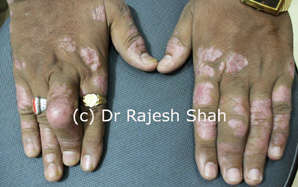Symptoms of Psoriatic Arthritis
The most common picture is a patient suffering from Psoriasis starts experiencing pain and stiffness in the joints. The stiffness is most marked in the morning or after rest. The stiffness may be worse in initial movements but may gradually reduce with continuous movements or as the day progresses.
 The symptoms may be of varying severity, ranging from mild, moderate or severe. The patient may experience pain in the ankles, knee, elbows or shoulders or the back.
The symptoms may be of varying severity, ranging from mild, moderate or severe. The patient may experience pain in the ankles, knee, elbows or shoulders or the back.
Sometimes the pain and swelling may be severe and incapacitating, causing the restriction in movements, with the affected joint looking, red, hot and inflamed.
Sometimes only one or two small joints of the finger or toes may be involved, but presenting with swelling of the entire digit, giving them the appearance of a "sausage".
The characteristics of Psoriatic Arthritis are asymmetrical joint affections.
Psoriatic arthritis can also cause inflammation of the spine (spondylitis) and the sacrum, causing pain and stiffness in the low back, buttocks, neck and upper back. Psoriatic spondylitis is more common in men. Around 50 % of these patients have spondylitis and 50 % suffer from sacroiliitis
The back disease is usually slowly progressive with little radiological deterioration as compared with Ankylosing Spondylitis.
Nail changes are commonly seen in psoriatic arthritis. Pitting and ridges are seen in finger and toenails of 80% of patients with psoriatic arthritis.
Clinical Symptoms:
Psoriatic arthritis may be present with or without obvious skin eruptions, with minimal skin eruptions or with only nail deformity.
In some patients arthritis appears before psoriasis; in these cases, one may detect a family history of psoriasis.
Sometimes psoriasis of the scalp may have passed off as dandruff.
Inflammation at the sites where tendons and ligaments attach to the bone is a characteristic of Psoriatic Arthritis. The enthesis is composed of fibrocartilage and collagen and it aides to absorb and dissipate mechanical stress. Psoriatic Arthritis chiefly affects this site, where the tendons and ligaments attach the bones, and here, it becomes different from Rheumatoid Arthritis.
Patients with psoriatic arthritis can also develop inflammation of the tendons (tendonitis) and around cartilage. Inflammation of the tendon behind the heel causes Achilles tendonitis, leading to pain with walking and climbing stairs. Inflammation of the chest wall and of the cartilage that links the ribs to the breastbone (sternum) can cause chest pain, as seen in costochondritis.
Initial symptoms may be acute. When localized to the foot or toe, symptoms may be mistaken for gout. Around 5 % of patients with psoriatic arthritis may have an associated raised serum uric acid.
Written & Approved by-
Dr. Rajesh Shah
M.D. (Hom.)